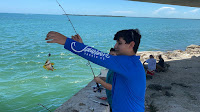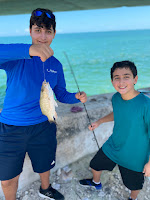Eager to go fishing at a new location after spending pretty much an entire summer at home and taking classes, I convinced my family, who also desperately wanted to leave the house, to head down to the Keys, a fisherman's paradise, where I could go fishing with my brother. We headed to the Channel 5 bridge, a location I had heard much about and had wanted to fish for quite a while. On the way I stopped at two different bait shops. At the first, I had planned to get live shrimp and maybe some ballyhoo as a backup plan. I entered the store with my bait bucket and aerator, but upon seeing the bucket, the woman at the cash register immediately told me that they unfortunately did not have any live shrimp, seeing as how in the summer months it is harder to acquire them. I settled for frozen ballyhoo and chum, which happened to be all I needed. She kindly instructed me to check out the marina behind the Bass Pro Shops a bit further south and closer to the bridge to see if they had any shrimp, but they only had mostly small dead ones. Nevertheless, I self picked as many adequate shrimps that I could and payed less that $4 for the "dozen." I had a pack of 6 ballyhoo, a block of chum, and some shrimp, and I was ready to go fishing.
The bridges on the way, from the southern tip of the Florida peninsula to Islamorada and on, were awesome. The blue water and the multi-colored reefs were always, of course, quite the sight. I'm very glad to be able to live in an area so close to such pristine nature and fishing grounds. We arrived at the pier next to the bridge and started fishing We arrived as the tide was reaching it's lowest point. Seeing as the channel marks a passage in between Florida Bay and the Atlantic Ocean, it is not surprising that the current was very strong and that single egg and split shot sinkers did not suffice to keep the bait on the bottom. I had to put on extra sinkers to keep the bait on the bottom. Soon after we started, Jacob hooked up and reeled in a small Porkfish that took his shrimp. The colors of the fish matched the colors of the water and the nearby reefs. It truly was a great spot to fish, what with the sights and fishing quality. We were glad to start off the day with a catch, albeit small. We waited for the sun to defrost the chum, and we used the knife to cut up the block and toss out pieces. After fishing on the bridge in direct exposure from the sun and heavy current that made the chum less effective as we had hoped without a chub bag, we decided to pack up and he'd to another spot on the channel that was under the bridge, closer to the base. There was ample space both on the bridge and under it at the second spot to which we had moved to maintain social distancing and negate the need for a mask.
Under the bridge and in the shade, it was very calm and nice. Being so close to the water really helped, too. We could get away with less weight and the chum was more fictive. We got into the bites soon after we settled. At first my brother and I switched off with the shrimp and the ballyhoo. The ballyhoo wasn't being taken very much at first, but the shrimp did catch fish. My first fish of the day, on shrimp, was a small French Grunt. Also on shrimp, Jacob and I started off with a few small Mangrove Snappers, which were there in abundance. He caught 2 and I caught 1. But then I decided to target the bigger fish and switched to the cut bait, while Jacob was satisfied trying to catch fish on the tried and true shrimp to which he was accustomed. He caught another Porkfish. While we were happy he caught something, I suggested he switched to the ballyhoo. I was using it, and it was working well because of how thick and sturdy it was, so it was much harder for fish, specifically the smaller ones, to take it off the hook. He ended up switching, which proved to be the right move. I baited his hook with his first piece of Ballyhoo, and he immediately hooked up with a nice fish. It was taking line off the reel and Jacob struggled to hold the rod still and reel in. I helped him land the fish by grabbing the line and pulling it over the ledge, and it was in; Jacob's PB Mangrove Snapper, a keeper of 10.5 inches. While this wasn't the biggest Snapper I'd seen, we were both ecstatic to have brought in Jacob's best Mangrove Snapper. While we stuck with the cut bait, we both kept on reeling in keepers. We outfished the others under the bridge by far. Since we didn't have a cooler and had no intention of keeping the fish, even if they were legal, we gave the legal ones to the other people fishing near us. After reeling in some more quality fish, we ended with a 12 inch Mangrove Snapper, our biggest of the day. It was around 3 o'clock when we left, which means that we had been fishing for around 4 hours.
All in all, it was a great day. I caught 2 French Grunts on the shrimp and 3 Mangrove Snappers on the cut ballyhoo (2 of which were keepers) while Jacob ended with a French Grunt and 2 Porkfish on shrimp and 6 Mangrove Snappers, some on shrimp and some on ballyhoo, 3 of which were legal to keep. Truthfully, fishing in the keys feels like a rite of passage, a necessary pilgrimage for fisherman, both land based and from boats. It's an incredible area, and especially in the region around Islamorada, very fishing oriented. The towns and waters seem like they were made for fishing and diving. The Keys truly are a fisherman's paradise. It was great to get out of the house and experience this magnificent environment once again, catching some quality fish in the process.



























